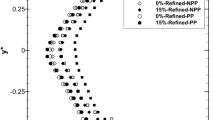Abstract
Due to influence of compressibility, shock wave, instabilities, and turbulence on supersonic flows, current flow visualization and imaging techniques encounter some problems in high spatiotemporal resolution and high signal-to-noise ratio (SNR) measurements. Therefore, nanoparticle based planar laser scattering method (NPLS) is developed here. The nanoparticles are used as tracer, and pulse planar laser is used as light source in NPLS; by recording images of particles in flow field with CCD, high spatiotemporal resolution supersonic flow imaging is realized. The flow-following ability of nanoparticles in supersonic flows is studied according to multiphase flow theory and calibrating experiment of oblique shock wave. The laser scattering characteristics of nanoparticles are analyzed with light scattering theory. The results of theoretical and experimental studies show that the dynamic behavior and light scattering characteristics of nanoparticles highly enhance the spatiotemporal resolution and SNR of NPLS, with which the flow field involving shock wave, expansion, Mach disk, boundary layer, sliding-line, and mixing layer can be imaged clearly at high spatiotemporal resolution.
Similar content being viewed by others
References
Bergmann V, Meier W, Wolff D, et al. Application of spontaneous raman and rayleigh scattering and 2D LIF for the characterization of a turbulent CH4/H2/N2 jet diffusion flame. Appl Phys B, 1998, 66(4): 489–502
Forkey J N, Lempert W R, Miles R B. Accuracy limits for planar measurement of flow field velocity, temperature and pressure using filtered rayleigh scattering. Exp Fluids, 1998, 24(2): 151–162
Boguszko M, Elliott G S. On the use of filtered rayleigh scattering for measurements in compressible flows and thermal fields. Exp Fluids, 2005, 38(1): 33–49
Watsona K A, Lyons K M, Donbarb J M, et al. Simultaneous rayleigh imaging and CH-PLIF measurements in a lifted jet diffusion flame. Combust Flame, 2000, 123(2): 252–265
Stanislas M, Okamoto K, Kähler C J, et al. Main results of the second international PIV challenge. Exp Fluids, 2005, 39(2): 170–191
Stier B, Koochesfahani M M. Molecular tagging velocimetry (MTV) measurements in gas phase flows. Exp Fluids, 1999, 26(3): 297–304
Fan J C. Modern Flow Visualization. Beijing: National Defense Industry Press, 2002. 418–435
Herring G C, Hillard M E. Flow visualization by elastic light scattering in the boundary layer of a supersonic flow. NASA/TM-2000-210121, 2000
Elliott G S, Glumac N, Carter C D. Molecular rayleigh scattering applied to combustion and turbulence. AIAA Paper 99-0643, 1999
Haertig J, Havermann M, Rey C, et al. Particle image velocimetry in mach 3.5 and 4.5 shock-tunnel flows. AIAA J, 2002, 40(6): 1056–1060
Khalitov D A, Longmire E K. Simultaneous two phase PIV by two-parameter phase discrimination. Exp Fluids, 2002, 32(2): 252–268
Meyers J F. Doppler global velocimetry—the next generation. AIAA Paper 92-3897, 1992
Meyer T R. Accuracy and resolution issues in NO/acetone PLIF measurements of gas-phase molecular mixing. Exp Fluids, 2002, 32(5): 603–611
Falco R E, Chu C C. Measurement of two dimensional fluid dynamic quantities using a photochromic grid tracing technique. Proc SPIE, 1987, 814(7): 706–710
Teets R E. Accurate convolutions of coherent anti-stokes raman spectra. Opt Lett, 1984, 9(2): 226–228
Melling A. Seeding gas flows for laser anemometry. In: AGARD CP-399: Conference on Advanced Instrumentation for Aero Engine Components. Neuilly Sur Seine: North Atlantic Treaty Organization, 1986, 8.1–8.11
Wiscombe W J. Improved Mie scattering algorithms. Appl Opt, 1980, 19(9): 1505–1509
Author information
Authors and Affiliations
Corresponding author
Additional information
Supported by the National Natural Science Foundation of China (Grant No. 10672178)
Rights and permissions
About this article
Cite this article
Zhao, Y., Yi, S., Tian, L. et al. Supersonic flow imaging via nanoparticles. Sci. China Ser. E-Technol. Sci. 52, 3640–3648 (2009). https://doi.org/10.1007/s11431-009-0281-3
Received:
Accepted:
Published:
Issue Date:
DOI: https://doi.org/10.1007/s11431-009-0281-3




